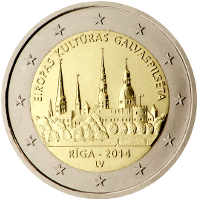 |
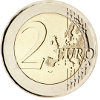 |
C o m m e m o r a t i v e
C o i n s |
||
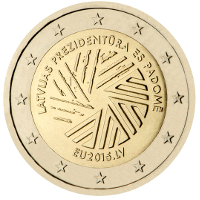 🔎
🔎 |
 |
Latvia | 10 Feb. 2015 | EU Presidency |
20001 20002 20005 |
1,025,000 |  |
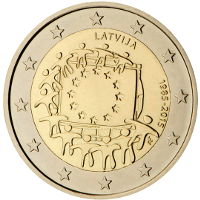 🔎
🔎 |
 |
Latvia | 03 Nov. 2015 | 30th anniversary of the EU‐Flag |
20001 20002 20005 |
1,010,000 |  |
National characteristics : Above is the name of the issuing country "LATVIJA" (Latvia), followed by the dates "1985‐2015". The coin was minted without mintmarks by the German mint Staatliche Münzen Baden‐Württemberg in Stuttgart. |
|||||||
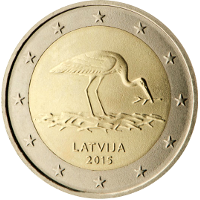 🔎
🔎 |
 |
Latvia | 01 Dec. 2015 | Stork |
20001 20002 20005 |
1,000,000 |  |
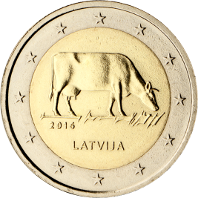 🔎
🔎 |
 |
Latvia | 19 Jul. 2016 | Latvian agriculture industry |
20001 20002 20005 |
1,010,000 |  |
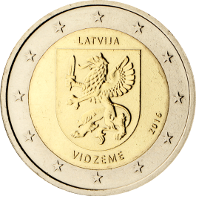 🔎
🔎 |
 |
Latvia | 15 Nov. 2016 | Vidzeme (Livland) 1st coin of the Historical Regions series |
20001 20002 20005 |
1,010,000 |  |
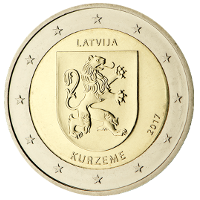 🔎
🔎 |
 |
Latvia | 14 Nov. 2017 | Kurzeme (Courland) 2nd coin of the Historical Regions series |
20001 20002 20005 |
500,000 |  |
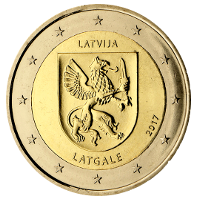 🔎
🔎 |
 |
Latvia | 14 Nov. 2017 | Latgale 3rd coin of the Historical Regions series |
20001 20002 20005 |
500,000 |  |
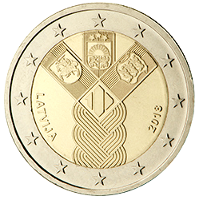 🔎
🔎 |
 |
Latvia | 31 Jan. 2018 | Establishment of the states of Estonia and Latvia, Re-establishment of the state of Lithuania Common Issue of the three Baltic States |
20001 20002 20005 |
512,000 |  |
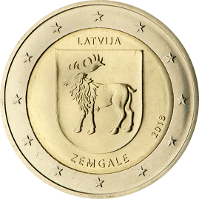 🔎
🔎 |
 |
Latvia | 26 Sep. 2018 | Zemgale (Semigallia) 4th coin of the Historical Regions series |
20001 20002 20005 |
507,000 |  |
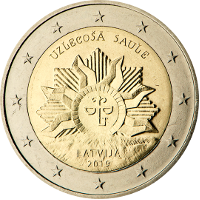 🔎
🔎 |
 |
Latvia | 17 Sep. 2019 | Coat of arms of Latvia's rising sun |
20001 20002 20005 |
307,000 |  |
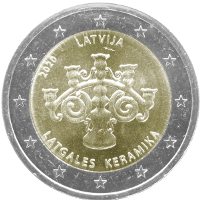 🔎
🔎 |
 |
Latvia | 05 Jun. 2020 | Letgalian ceramics |
20002 20007 20008 |
412,000 |  |
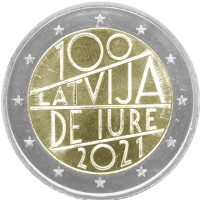 🔎
🔎 |
 |
Latvia | 20 Jan. 2021 | 100th anniversary of the recognition of the Republic of Latvia |
20002 20007 20008 |
412,000 |  |
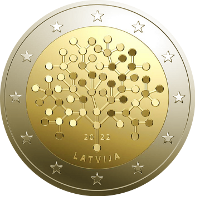 🔎
🔎 |
 |
Latvia | 12 Apr. 2022 | 100 years of Bank of Latvia |
20003 20005 |
415,000 |  |
 Work in progress |
|||||||
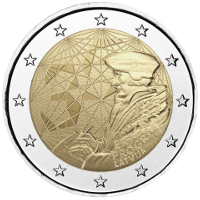 🔎
🔎 |
 |
Latvia | 01 Jul. 2022 | 35th anniversary of the Erasmus Program |
20003 20005 20009 |
308,000 |  |
National characteristics : The quarter circle at the bottom right has four lines; below the commemorative period the occasion of issue "ERASMUS PROGRAMMA" (Erasmus programme in Latvian) is written in two lines, below it the issuing country "LATVIJA" (Latvia). The coin was produced without a mint mark by the Lithuanian mint Lietuvos monetų kalykla in Vilnius. The coin belongs to those with a more structured background. |
|||||||
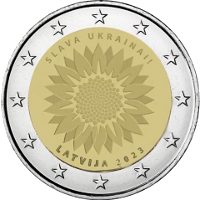 🔎
🔎 |
 |
Latvia | 30 May 2023 | The Sunflower of Ukraine |
20003 20008 20009 |
410,000 |  |
| References : | |||
| 20001 | Images taken with authorisation by the ECB ‐ Mail dated 20.Feb.2020 © "European Central Bank" |
20002 | Data mirrored from Wikipedia Page "2_euro_commemorative_coins" with friendly support of the guardians of that page. |
| 20003 | Images taken with authorisation by H....... Hamburg | 20004 | Coloured version of this Commemorative Coin in circulation EU‐legal‐technical specifications do not recongnise colour prints. The EU nevertheless tolerates them, as their numbers are very small and they are sold in special packs and therefor are very unlikely to be used as currency. |
| 20005 |
enlarged Images taken with authorisation by Gerd Seyffert © "Gerd Seyffert 2021" |
20006 | Not Applicable |
| 20007 | Images taken by Münzen Kreuzberg © "Münzen Kreuzberg 2021" |
20008 | enlarged Images taken by Münzen Kreuzberg © "Münzen Kreuzberg 2021" |
| 20009 | Text with kind permission by Gerd Seyffert © "Gerd Seyffert 2023" |
20010 | Not Applicable |
 |

